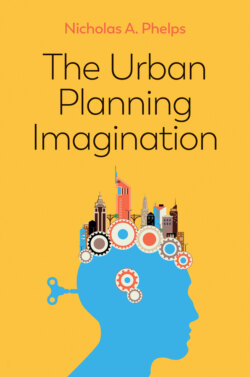The Urban Planning Imagination

Реклама. ООО «ЛитРес», ИНН: 7719571260.
Оглавление
Nicholas A. Phelps. The Urban Planning Imagination
Table of Contents
List of Tables
List of Illustrations
Guide
Pages
Dedication
The Urban Planning Imagination. A Critical International Introduction
Copyright Page
List of figures and tables. Figures
Tables
Preface
1 Introduction: what is planning? Introduction
The urban planning imagination
Who plans?
History and the urban planning imagination
Geography and the urban planning imagination
Urban planning’s enduring appeal
The structure of the book
Notes
2 Imagination: what is planning’s spirit and purpose? Introduction
Who plans?
Citizens
Clubs
States
Mixes of actors
The history and temporality of planning
Macro-historical change: empires, economic systems and states
Meso-level institutions of states
The micro-level
The temporalities of urban planning
The geography of the urban planning imagination
Bounded places: neighbourhood, city, region, nation, metropolis and megalopolis
Sites and neighbourhoods
Regional planning
Megalopolitan realities
National planning
Networks, flows and virtual urban planning
Cities as nodes within networks
Flows: the metabolism of cities
Virtuality and synchronicity
Conclusion
Notes
3 Substance: what are the objects of planning? Introduction
Shelter
Cities without slums: seeing like a state
Housing as externality: club solutions to state failings
House as home: the latent informality of household desires
Health
Water, food and air
The infirmity of the city?
Mobility
Automobility and its systemic urban planning legacies
High-speed rail and aeromobility: the interplaces yet to come?
Virtual mobility and its effects
Sustainability
Environmental designations: the paradoxes of planning for the city and its other
Eco- and other city forms
Urban metabolism in an urban age of climate change and hazards
Economy
Economic growth: a state obsession
The circular urban economy
The alternative economies of clubs and citizens
Conclusion
Notes
4 Wisdom: what does planning teach us? Introduction
Justice and equity
The tragedy of the commons and other wicked problems
Urban planning, externalities and land-value capture
Externalities
Private property, externalities, betterment and compensation
Unintended consequences
Planning failures great and small
Self-fulfilling prophecies of planning for mobility
Failures to plan with nature
Inabilities to control urban sprawl
Participation and the lack of it
Conclusion
Notes
5 Methods: what are the means of planning? Introduction
City as organism: the art and science of urban planning
City as system: the predicting, providing and nudging of the state
Smart cities: the city as a mine of data
City as scenario: clubthink
Cities and citizens: participation in planning
Public participation
Communicative action and urban planning
Planning without statutory planning: agonism, co-production and radicalism
Mixes of methods for new urban planning imaginaries
Planning’s artistry
Experimentation
Planning rhetoric
Conclusions
Notes
6 Comparisons: what are the global variations in planning? Introduction
Comparative approaches
Politics, political and administrative science
Geography and history
National planning systems and cultures
Planning systems: formal contrasts in law and administration
Culture: the local personalities of planning
Models of welfare and national economic development
Liberal markets
European welfare models
Predatory systems
South Asian democracies
Developmental systems
China
Born globals
Conclusion
Notes
7 Exchanges: what are the global connections in planning? Introduction
The who, what and how of exchange
Nation states, empires and urban planning
Urban planning’s global iron cage?
The Europeanization of urban planning
Global urban planning governance?
Clubs: planning for extraordinary desires
The seductive power of urban planning
Urban planning by and for a TCC
Urban planning and the mediation of urban tastes
Pick-and-mix planning
Citizens: planning for ordinary needs
Conclusion
Notes
8 Prospects: what is the future of planning? Introduction
The limits of citizens, clubs and states as urban planners
Citizens
Planning in the name of clubs
W(h)ither the state?
The city as laboratory: productive mixes of the urban planning imagination?
Conclusion: urban planning’s disciplinary dialogues
References
Index
POLITY END USER LICENSE AGREEMENT
Отрывок из книги
For 苗田
Yulia Elizabeth Phelps
.....
To be effective, planners need to be able to contribute on a given issue for a period of time (Krumholz, 1982). The problem is that churn is a feature of the careers of trained urban planners regardless of which citizen, club or state actors they work in the service of. Even the lesser time frames discussed above may exceed the tenure of individual planners. The meso-historical time frames needed to resolve some urban planning challenges far exceed those of particular institutional configurations of statutory planning, let alone the lives of individual citizens or trained urban planners. For example, ‘even though the science and use of scenarios in climate change projections might suggest the need for a long-term view, UK planners and planning authorities have … been inhibited in taking a long-term perspective or in engaging with futures thinking’ (Wilson, 2009: 223). In macro-historical terms, the urban planning imagination is revealed as seeking for resilience and gradual adjustment to climate change and events, but it is questionable whether and how it can respond in the short term to the increasing frequency and greater severity of climate events (Halsnæs and Laursen, 2009: 83).
Across the global south, time is a resource that citizens know how to exploit. Inaction by states, or their inabilities to fully enforce regulations, become opportunities for income generation in tactical adjustments by street vendors (Recio, 2021). Waiting for the state to act opens the way to the autoconstruction of housing (Oldfield and Greyling, 2015). In both instances the citizen–state relationship is reconstituted. The temporal interstices of urban planning are essential to understanding some of the creative energies of global south citizens in resisting some of the institutionalized divisiveness of statutory planning.
.....